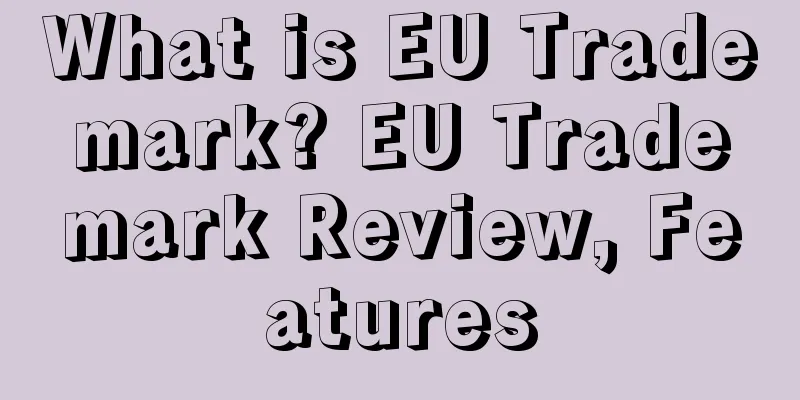What is EU Trademark? EU Trademark Review, Features

|
A European Union trademark is a mark registered by OHIM (Office for Harmonization in the Internal Market) in accordance with the conditions of the CTMR (Community Trademark Regulation), which is valid throughout the European Union and is used to identify and distinguish goods or services.
Introduction to EU Trademark EU trademarks run in parallel with domestic trademarks in EU countries and do not conflict with each other. However, trademarks that have been registered or applied for registration in EU countries constitute prior rights to oppose EU trademark registration, and vice versa. The signs that can be registered as EU trademarks include words, graphics, three-dimensional signs, colors, and sounds, but they must be distinctive (able to be distinguished from other products and services), be able to be clearly and objectively represented, and must not conflict with prior rights. Purely descriptive signs, that is, signs that only describe the characteristics of products or services, cannot be registered as EU trademarks. EUIPO divides trademarks into individual marks, collective marks, and certification marks. Individual trademarks are actually ordinary trademarks, and both natural persons and organizations can apply for registration. Collective marks and certification marks are no different from those in my country. EU registered trademark rights holders enjoy the exclusive right to use the trademark in all current and future EU member states. EU Trademark Registration Routes 1. Apply for registration directly to EUIPO; 2. Submit an application for international trademark registration and designate the European Union as the effective region. EUIPO recognizes 6 months of international priority. If you apply for the same trademark registration again in the EU within 6 months after the first application for trademark registration in China, you can enjoy priority. If you apply for trademark registration within 6 months after the first exhibition of the product at an international exhibition officially held or recognized by the EU, you can also claim exhibition priority. EU Trademark Registration Procedure 1. Submit your application Applying directly to EUIPO is divided into online application and paper application. The online application fee is lower (official fee is 850 euros) and only one language is required. EUIPO also has a fast application channel, which can speed up the EUIPO review process and publish the registration application as soon as possible. 2. Review After receiving the application, EUIPO will conduct an examination and notify the applicant to make corrections within 2 months if any problems are found. If the corrections are not made within the prescribed time, EUIPO will reject the application or claim in whole or in part. If you are dissatisfied with the decision of EUIPO, you can appeal to the Appeal Committee within EUIPO. If you are dissatisfied with the decision of the Appeal Committee, you can appeal to the General Court of the European Union. The judgment of the General Court of the European Union can also be appealed to the Court of Justice of the European Union. However, EUIPO does not proactively examine whether there are prior rights when examining trademark registration applications. Prior rights holders can protect their rights through procedures such as objections and requests for invalidation. 3. Public application and objection If there are no problems with the EUIPO review, the registration application will be published in the EUTM Bulletin. Anyone who believes that the trademark applied for registration infringes their prior rights can raise an objection within 3 months after the application is published. EUIPO will organize the procedures for both parties and make a final decision. If you are dissatisfied with the final decision of EUIPO, you can appeal according to the above steps. Anyone who believes that the trademark applied for registration does not meet the conditions for trademark registration can make observations to EUIPO. There is no fee for making opinions. EUIPO will inform the applicant and consider it. 4. Registration and Publicity If no one raises an objection or opinion within the specified time, or the objection or opinion is not valid, EUIPO will register it, publish it in the EU Trademark Gazette and issue an electronic registration certificate. EU trademarks must be put into use within 5 years after registration, otherwise anyone can file an application for non-use cancellation. Anyone can also apply to EUIPO to cancel a registered trademark or declare it invalid. If you are dissatisfied with the final decision of EUIPO, you can also appeal according to the above steps. If a EU registered trademark is transferred or licensed to others, it should be recorded in EUIPO. Registration Time The receipt time for EU trademark registration is about 1 week, the examination time is 3 months (no objection, rejection, etc.), the certification time is 4-6 months, and the trademark is valid for 10 years. EU Trademark Validity Period A registered EU trademark is valid for 10 years and can be renewed indefinitely. Advantages 1. Low registration fee: You only need to apply for registration once to use the trademark in all 28 member states of the European Union. 2. More comprehensive trademark protection: centralized protection, wide protection scope, and convenient handling of trademark disputes. One trademark registration can obtain protection in 28 EU member states; 3. Revocation of protection: The use of a trademark in any country of the European Union can counter the application for revocation of a trademark that has not been used for five years; 4. Paris Convention priority: The same trademark is used for one or more designated goods or service names. When applying for a Community trademark in a Paris Convention member country 6 months after the application, it can enjoy priority; 5. Priority: A registered trademark that has been published in an EU member state can request priority registration when applying for an EU trademark. Disadvantages 1. High requirements for trademark distinctiveness: Community trademark registration has high requirements for trademark distinctiveness. If one of the 28 member states of the Community raises an objection and the objection is established, the entire Community trademark registration will be rejected. Although the rejected trademark can be converted into a national application and the original Community trademark application date is retained, the applicant must still pay the conversion fee to each country. Therefore, if the selected trademark is not very distinctive, it is not suitable for applying for Community trademark registration. 2. Registration is difficult: It is difficult to determine the time to apply for community trademark registration at the Office for Harmonization in the Internal Market. If everything goes well, the trademark may be registered within a year. However, as long as one country raises an objection, the trademark cannot be registered in time. It takes a long time to resolve the objection, usually about 2 years. It is rare that there is no objection in all 27 countries. Therefore, community trademark applications are often not approved for registration for a long time. cost
Required documents If you are a legal person, please attach a copy of your business license or valid registration certificate; if you are a natural person, please attach a copy of your personal identity document; 5 copies of the trademark drawing, which must be clear and made of good quality paper. If it is a color trademark, 1 black and white draft and 5 color drafts must be submitted; the size must not be less than 5cm×5cm and the maximum size must not exceed 10cm×20cm; Fill out an application form, which must be signed by the applicant or an agent, listing the goods or services for which registration is sought, indicating the trademark category and the trademark classification table. A power of attorney for trademark registration, which the applicant must sign and seal. EU Trademark Regulation Revocation 1. Anyone who finds that a registered trademark of the European Community has not been used in real terms for five consecutive years in accordance with the law may submit an application to the Internal Affairs Bureau to cancel the registered trademark. Unless it can be proved that there are special reasons permitted by law, the registered trademark will be cancelled according to law. 2. Anyone who finds that a Community registered trademark has become a generic name or that its use will mislead the public may submit an application to the Internal Relations Office to cancel the registered trademark. 3. The holder of a prior trademark right may submit an application based on his prior rights, requesting the Internal Trademark Office to declare the subsequent conflicting EC registered trademark invalid. 4. When a trademark infringement lawsuit occurs, an application for cancellation of the Community registered trademark or declaration of its registration invalid shall be submitted at the same time. The courts of EU countries shall have jurisdiction and may rule to cancel the Community registered trademark or declare it invalid in accordance with the law. 5. For applications directly submitted to cancel the EC registered trademark or declare other invalidity, only the Internal Affairs Bureau will accept it. If you are dissatisfied with the ruling made by the Internal Affairs Bureau, you can file a lawsuit with the International Court of Justice of the European Union. Infringement 1. Use a trademark that is identical or similar to a trademark registered in the European Community in any EU country and use it on similar goods/services. Using a trade mark that is identical or similar to another person's Community registered trade mark that has achieved a high reputation on dissimilar goods/services. 2. Each EU country must designate a special court to hear lawsuits for infringement of the Community registered trademark, as well as lawsuits for the cancellation of the Community registered trademark or its invalidation. When the court examines the above cases, the pure Community trademark dispute case is subject to the Community Trademark Law, while the case involving damages is subject to the laws of the country where the case is held. 3. Under a special agreement between the two parties, the infringement lawsuit can be filed in the country where the defendant is based or has its main business premises; otherwise, the infringement lawsuit should be filed in the country where the plaintiff has its residence or main business premises. If neither party has a residence or business premises in any EU country, the infringement lawsuit should be filed in Spain. The courts established by EU countries to accept EC trademark infringement lawsuits have jurisdiction over all infringements occurring within the EU. 4. An infringement action may also be filed in the country where the infringement occurred, but the jurisdiction of the courts of that country will be limited to damages for the infringement that occurred in that country. |
<<: What is a hot item? Hot item Review, Features
>>: What is Amazon for Teens? Amazon for Teens Review, Features
Recommend
What is Fakespot? Fakespot Review, Features
Fakespot is the best tool on the market for detec...
Breaking news! A large number of nodes in one category of Amazon disappeared, and sales plummeted
After a week of intense work, sellers are looking...
Feishu Sino held a technology conference, SinoClick ushered in a new upgrade
Shanghai , July 8, 2021 - Today , Feishu Sino suc...
Second-hand e-commerce platforms ThredUP and Mercari develop new shopping experiences
In recent years, second-hand goods have been gain...
What is Helmut Lang? Helmut Lang Review, Features
Helmut Lang is a multidisciplinary brand that blen...
What is Qutoutiao? Qutoutiao Review, Features
Qutoutiao is an APP developed by Shanghai Jifen C...
What is plentymarkets? plentymarkets Review, Features
<span data-docs-delta="[[20,{"gallery"...
A "special" young man born in 1998 started a cross-border e-commerce business, with over 7,000 orders a day!
A "special" young man born in 1998 star...
What is Vestiaire Collective? Vestiaire Collective Review, Features
Vestiaire Collective was founded in France in 200...
The job hunting wave is coming! A large number of workers are "seeking change"
After the Spring Festival, more and more cross-bo...
Amazon sellers begin rushing to TikTok
The opportunity of 2024 has emerged. Recently, th...
Annual sales of 2.1 billion! Big sellers saw orders increase by more than 60% in the first half of the year
According to the "2020 Southeast Asian Inter...
What is SaleTurf? SaleTurf Review, Features
SaleTurf is designed to increase product visibilit...
What is Mo Dao Sang Yu? Mo Dao Sang YuReview, Features
The Modaosangyu Cross-border Business Department,...
Cross-border sales of Paton, but still 630 million yuan uncollected! Global Easybuy's main business has basically stagnated...
Shenzhen Global Easybuy's main business has b...









